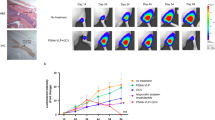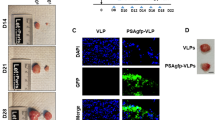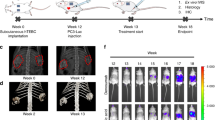Abstract
In an effort to develop a new therapy for prostate cancer (PCa) bone metastases, we have created Ad.dcn, a recombinant oncolytic adenovirus carrying the human decorin gene. Infection of PC-3 and DU-145, the human prostate tumor cells, with Ad.dcn or a non-replicating adenovirus Ad(E1-).dcn resulted in decorin expression; Ad.dcn produced high viral titers and cytotoxicity in human prostate tumor cells. Adenoviral-mediated decorin expression inhibited Met, the Wnt/β-catenin signaling axis, vascular endothelial growth factor A, reduced mitochondrial DNA levels and inhibited tumor cell migration. To examine the antitumor response of Ad.dcn, PC-3-luc cells were inoculated in the left heart ventricle to establish bone metastases in nude mice. Ad.dcn, in conjunction with control replicating and non-replicating vectors were injected via tail vein. The real-time monitoring of mice, once a week, by bioluminescence imaging and X-ray radiography showed that Ad.dcn produced significant inhibition of skeletal metastases. Analyses of the mice at the terminal time point indicated a significant reduction in the tumor burden, osteoclast number, serum tartrate-resistant acid phosphatase 5b levels, osteocalcin levels, hypercalcemia, inhibition of cancer cachexia and an increase in the animal survival. Based on these studies, we believe that Ad.dcn can be developed as a potential new therapy for PCa bone metastasis.
This is a preview of subscription content, access via your institution
Access options
Subscribe to this journal
Receive 12 print issues and online access
$259.00 per year
only $21.58 per issue
Buy this article
- Purchase on Springer Link
- Instant access to full article PDF
Prices may be subject to local taxes which are calculated during checkout






Similar content being viewed by others
References
Cancer Facts and Figures 2013. http://www.cancer.org/Research/cancer-facts-figures-2013.
Coleman RE . Metastatic bone disease: clinical features, pathophysiology and treatment strategies. Cancer Treat Rev 2001; 27: 165–176.
Sturge J, Caley MP, Waxman J . Bone metastasis in prostate cancer: emerging therapeutic strategies. Nat Rev Clin Oncol 2011; 8: 357–368.
Gartrell BA, Saad F . Managing bone metastases and reducing skeletal related events in prostate cancer. Nat Rev Clin Oncol 2014; 11: 335–345.
Deng X, He G, Liu J, Luo F, Peng X, Tang S et al. Recent advances in bone-targeted therapies of metastatic prostate cancer. Cancer Treat Rev 2014; 40: 730–738.
Camacho DF, Pienta KJ . A multi-targeted approach to treating bone metastases. Cancer Metastasis Rev 2014; 33: 545–553.
Suzman DL, Boikos SA, Carducci MA . Bone-targeting agents in prostate cancer. Cancer Metastasis Rev 2014; 33: 610–628.
Lee RJ, Smith MR . Targeting MET and vascular endothelial growth factor receptor signaling in castration-resistant prostate cancer. Cancer J 2013; 19: 90–98.
Lipton A, Balakumaran A . Denosumab for the treatment of cancer therapy-induced bone loss and prevention of skeletal-related events in patients with solid tumors. Expert Rev Clin Pharmacol 2012; 5: 359–371.
Fizazi K, Carducci M, Smith M, Damiao R, Brown J, Karsh L et al. Denosumab versus zoledronic acid for treatment of bone metastases in men with castration-resistant prostate cancer: a randomised, double-blind study. Lancet 2011; 377: 813–822.
Bischoff JR, Kirn DH, Williams A, Heise C, Horn S, Muna M et al. An adenovirus mutant that replicates selectively in p53-deficient human tumor cells. Science 1996; 274: 373–376.
Seth P (ed) Adenoviruses: Basic Biology to Gene Therapy. R G Landes Company: Austin, TX, USA, 1999.
Yamamoto M, Curiel DT . Current issues and future directions of oncolytic adenoviruses. Mol Ther 2010; 18: 243–250.
Choi IK, Yun CO . Recent developments in oncolytic adenovirus-based immunotherapeutic agents for use against metastatic cancers. Cancer Gene Ther 2013; 20: 70–76.
Schenk E, Essand M, Bangma CH, Barber C, Behr JP, Briggs S et al. Clinical adenoviral gene therapy for prostate cancer. Hum Gene Ther 2010; 21: 807–813.
Hu Z, Gupta J, Zhang Z, Gerseny H, Berg A, Chen YJ et al. Systemic delivery of oncolytic adenoviruses targeting transforming growth factor-beta inhibits established bone metastasis in a prostate cancer mouse model. Hum Gene Ther 2012; 23: 871–882.
Xu W, Zhang Z, Yang Y, Hu Z, Wang CH, Morgan M et al. Ad5/48 hexon oncolytic virus expressing sTGFbetaRIIFc produces reduced hepatic and systemic toxicities and inhibits prostate cancer bone metastases. Mol Ther 2014; 22: 1504–1517.
Edwards IJ . Proteoglycans in prostate cancer. Nat Rev Urol 2012; 9: 196–206.
Henke A, Grace OC, Ashley GR, Stewart GD, Riddick AC, Yeun H et al. Stromal expression of decorin, Semaphorin6D, SPARC, Sprouty1 and Tsukushi in developing prostate and decreased levels of decorin in prostate cancer. PLoS One 2012; 7: e42516.
Neill T, Schaefer L, Iozzo RV . Decorin: a guardian from the matrix. Am J Pathol 2012; 181: 380–387.
Sofeu Feugaing DD, Gotte M, Viola M . More than matrix: the multifaceted role of decorin in cancer. Eur J Cell Biol 2013; 92: 1–11.
Neill T, Painter H, Buraschi S, Owens RT, Lisanti MP, Schaefer L et al. Decorin antagonizes the angiogenic network: concurrent inhibition of Met, hypoxia inducible factor 1alpha, vascular endothelial growth factor A, and induction of thrombospondin-1 and TIMP3. J Biol Chem 2012; 287: 5492–5506.
Buraschi S, Pal N, Tyler-Rubinstein N, Owens RT, Neill T, Iozzo RV . Decorin antagonizes Met receptor activity and down-regulates {beta}-catenin and Myc levels. J Biol Chem 2010; 285: 42075–42085.
Kypta RM, Waxman J . Wnt/beta-catenin signalling in prostate cancer. Nat Rev Urol 2012; 9: 418–428.
Cook LM, Shay G, Aruajo A, Lynch CC . Integrating new discoveries into the "vicious cycle" paradigm of prostate to bone metastases. Cancer Metastasis Rev 2014; 33: 511–525.
Varkaris A, Corn PG, Gaur S, Dayyani F, Logothetis CJ, Gallick GE . The role of HGF/c-Met signaling in prostate cancer progression and c-Met inhibitors in clinical trials. Expert Opin Investig Drugs 2011; 20: 1677–1684.
Zeng Y, Opeskin K, Goad J, Williams ED . Tumor-induced activation of lymphatic endothelial cells via vascular endothelial growth factor receptor-2 is critical for prostate cancer lymphatic metastasis. Cancer Res 2006; 66: 9566–9575.
Li X, Ling W, Khan S, Yaccoby S . Therapeutic effects of intrabone and systemic mesenchymal stem cell cytotherapy on myeloma bone disease and tumor growth. J Bone Miner Res 2012; 27: 1635–1648.
Li X, Pennisi A, Yaccoby S . Role of decorin in the antimyeloma effects of osteoblasts. Blood 2008; 112: 159–168.
Reed CC, Gauldie J, Iozzo RV . Suppression of tumorigenicity by adenovirus-mediated gene transfer of decorin. Oncogene 2002; 21: 3688–3695.
Goldoni S, Seidler DG, Heath J, Fassan M, Baffa R, Thakur ML et al. An antimetastatic role for decorin in breast cancer. Am J Pathol 2008; 173: 844–855.
Choi IK, Lee YS, Yoo JY, Yoon AR, Kim H, Kim DS et al. Effect of decorin on overcoming the extracellular matrix barrier for oncolytic virotherapy. Gene Ther 2010; 17: 190–201.
Zhang Z, Krimmel J, Hu Z, Seth P . Systemic delivery of a novel liver-detargeted oncolytic adenovirus causes reduced liver toxicity but maintains the antitumor response in a breast cancer bone metastasis model. Hum Gene Ther 2011; 22: 1137–1142.
Aftab DT, McDonald DM . MET and VEGF: synergistic targets in castration-resistant prostate cancer. Clin Transl Oncol 2011; 13: 703–709.
Guise T . Examining the metastatic niche: targeting the microenvironment. Semin Oncol 2010; 37: S2–14.
Chaffer CL, Weinberg RA . A perspective on cancer cell metastasis. Science 2011; 331: 1559–1564.
Munesue S, Yoshitomi Y, Kusano Y, Koyama Y, Nishiyama A, Nakanishi H et al. A novel function of syndecan-2, suppression of matrix metalloproteinase-2 activation, which causes suppression of metastasis. J Biol Chem 2007; 282: 28164–28174.
Dagda RK, Cherra SJ 3rd, Kulich SM, Tandon A, Park D, Chu CT . Loss of PINK1 function promotes mitophagy through effects on oxidative stress and mitochondrial fission. J Biol Chem 2009; 284: 13843–13855.
Neill T, Torres A, Buraschi S, Owens RT, Hoek JB, Baffa R et al. Decorin induces mitophagy in breast carcinoma cells via peroxisome proliferator-activated receptor gamma coactivator-1alpha (PGC-1alpha) and mitostatin. J Biol Chem 2014; 289: 4952–4968.
Ma Y, Galluzzi L, Zitvogel L, Kroemer G . Autophagy and cellular immune responses. Immunity 2013; 39: 211–227.
Seth P, Wang ZG, Pister A, Zafar MB, Kim S, Guise T et al. Development of oncolytic adenovirus armed with a fusion of soluble transforming growth factor-beta receptor II and human immunoglobulin Fc for breast cancer therapy. Hum Gene Ther 2006; 17: 1152–1160.
Hu Z, Robbins JS, Pister A, Zafar MB, Zhang ZW, Gupta J et al. A modified hTERT promoter-directed oncolytic adenovirus replication with concurrent inhibition of TGFbeta signaling for breast cancer therapy. Cancer Gene Ther 2010; 17: 235–243.
Katayose D, Gudas J, Nguyen H, Srivastava S, Cowan KH, Seth P . Cytotoxic effects of adenovirus-mediated wild-type p53 protein expression in normal and tumor mammary epithelial cells. Clin Cancer Res 1995; 1: 889–897.
Hu Z, Zhang Z, Guise T, Seth P . Systemic delivery of an oncolytic adenovirus expressing soluble transforming growth factor-beta receptor II-Fc fusion protein can inhibit breast cancer bone metastasis in a mouse model. Hum Gene Ther 2010; 21: 1623–1629.
Zhang Z, Hu Z, Gupta J, Krimmel JD, Gerseny HM, Berg AF et al. Intravenous administration of adenoviruses targeting transforming growth factor beta signaling inhibits established bone metastases in 4T1 mouse mammary tumor model in an immunocompetent syngeneic host. Cancer Gene Ther 2012; 19: 630–636.
Goldoni S, Humphries A, Nystrom A, Sattar S, Owens RT, McQuillan DJ et al. Decorin is a novel antagonistic ligand of the Met receptor. J Cell Biol 2009; 185: 743–754.
Cory G . Scratch-wound assay. Methods Mol Biol 2011; 769: 25–30.
Hu Z, Gerseny H, Zhang Z, Chen YJ, Berg A, Stock S et al. Oncolytic adenovirus expressing soluble TGFbeta receptor II-Fc-mediated inhibition of established bone metastases: a safe and effective systemic therapeutic approach for breast cancer. Mol Ther 2011; 9: 1609–1618.
Wang YX, Carlo FD, Mancini DC, McNulty I, Tieman B, Bresnahan J et al. A high-throughput X-ray microtomography system at the Advanced Photon Source. Rev Sci Instrum 2001; 72: 2062–2068.
Schneider A, Kalikin LM, Mattos AC, Keller ET, Allen MJ, Pienta KJ et al. Bone turnover mediates preferential localization of prostate cancer in the skeleton. Endocrinology 2005; 146: 1727–1736.
Acknowledgements
The work was funded in part by the National Institutes of Health grant # R01CA12738 (PS), grant # RO1CA39481 (RVI), and philanthropic support through John and Carol Walter Center for Urological Health, NorthShore University HealthSystem. Use of the Advanced Photon Source was supported by the US Department of Energy, Office of Science, Office of Basic Energy Sciences, under Contract No. DE-AC02-06CH11357. We are thankful to Janardan Khandekar, Theodore Mazzone, Bruce Brockstein and Michael Caplan for their continuous support.
Author information
Authors and Affiliations
Corresponding author
Ethics declarations
Competing interests
The authors declare no conflict of interest.
Rights and permissions
About this article
Cite this article
Xu, W., Neill, T., Yang, Y. et al. The systemic delivery of an oncolytic adenovirus expressing decorin inhibits bone metastasis in a mouse model of human prostate cancer. Gene Ther 22, 247–256 (2015). https://doi.org/10.1038/gt.2014.110
Received:
Revised:
Accepted:
Published:
Issue Date:
DOI: https://doi.org/10.1038/gt.2014.110
This article is cited by
-
The safety and efficacy of systemic delivery of a new liver-de-targeted TGFβ signaling inhibiting adenovirus in an immunocompetent triple negative mouse mammary tumor model
Cancer Gene Therapy (2024)
-
Exercise in advanced prostate cancer elevates myokine levels and suppresses in-vitro cell growth
Prostate Cancer and Prostatic Diseases (2022)
-
Exercise-induced myokines and their effect on prostate cancer
Nature Reviews Urology (2021)
-
The Adverse Effects of Androgen Deprivation Therapy in Prostate Cancer and the Benefits and Potential Anti-oncogenic Mechanisms of Progressive Resistance Training
Sports Medicine - Open (2020)
-
A framework for the development of effective anti-metastatic agents
Nature Reviews Clinical Oncology (2019)



